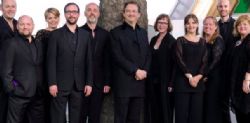|
Symphony
SRS SEASON ENDS WITH RESOUNDING TA-TA-TA-BANG
by Terry McNeill
Sunday, June 1, 2025
Symphony
YOUTHFUL VIRTUOSITY ON DISPLAY AT USO'S MAY CONCERTS
by Peter Lert
Saturday, May 17, 2025
Symphony
MYSTICAL PLANETS AND LIVELY GERSHWIN ORTIZ AT FINAL SRS CONCERT
by Peter Lert
Sunday, May 4, 2025
Symphony
VSO'S CONCERT MUSIC OF TIME, MUSIC OF PLACE
by Peter Lert
Sunday, April 27, 2025
Choral and Vocal
VOCAL ELEGANCE AND FIRE AT THE 222'S RECITAL APRIL 26
by Pamela Hicks Gailey
Saturday, April 26, 2025
CANTIAMO SONOMA SINGS AN INSPIRED GOOD FRIDAY MOZART REQUIEM CONCERT
by Pamela Hicks Gailey
Friday, April 18, 2025
DRAMATIC SHOSTAKOVICH SYMPHONY CLOSES PHILHARMONIC'S 25TH SEASON
by Terry McNeill
Sunday, April 13, 2025
LARGE COLLEGE OF MARIN AUDIENCE GREETS STOPHER ARTISTRY
by Terry McNeill
Saturday, April 5, 2025
Chamber
FRISSON DELIVERS SHIVERS OF DELIGHT
by Abby Wasserman
Sunday, March 30, 2025
OLD AND MOSTLY NEW IN SRS MARCH CONCERT IN WEILL
by Peter Lert
Saturday, March 22, 2025
|
 |
 Tallis Scholars |
SISTINE CHAPEL INSPIRATION FOR THE TALLIS SCHOLARS IN WEILL HALL
by Sonia Morse Tubridy
Friday, April 5, 2019
Returning to Weill Hall April 5 after a seven year absence, the ten singers of the Tallis Scholars brought the sacred choral tradition of Palestrina and his contemporaries to an audience of delighted music lovers. Under the direction of Peter Phillips, the 1973 founder of the group, the program was built around the Catholic Mass movements, using portions of five different masses Palestrina composed, interspersed with other composers of the high Renaissance period. This is music created for the Vatican and most particularly the inspiration of the Sistine Chapel.
Many of the masses are in the “parody mass form”, based on a preexisting motet. The opening was a Kyrie from Missa Assumpta Est Maria. There is little vocabulary to adequately extoll this choir in the beauty off its music making. The blend, the balance, the phrasing, the clarity, all immersing us in the glories of truly great polyphonic a cappella choral music. The sound of the Tallis Scholars was embraced by Weill’s acoustics of the hall and created transcendant musical experiences: stillness in motion, freedom in order, individual and group supporting and lifting each other. The music and performers became one in a tapestry of intertwining voices, clear and warm.
The second piece was a setting of Regina Caeli by Crisobal De Morales, who was one of the Spanish composers to benefit from the patronage of Spanish popes. It is a hymn to Mary and was intriguing in its rhythms and syncopations. Nothing in the interpretation was forced. Dynamics and tempo were masterfully chosen and the music spoke for itself.
Eight of the singers presented the Gloria from Palestrina’s Missa Ecce Ego Johannes. Solo and ensemble alternated in this music of praise. Remarkable always were the clarity of text and beautiful music of changing vowels and new dimensions of sound coloring. The end was a gloriously triumphant Amen.
Quam Pulcra Est by Constanzo Festa and Lamentations by Carpenters brought smaller groupings off singers with delicacy of treble voices and then dark low sounds of desolation and weeping. Lamentations ended on a somber note with a slow and moving cadence. Palestrina’s Credo from Missa Papae Marcelli, also sung by eight, brought an element of storytelling into the music. The text was given dramatic portrayal and built to new, organ like texture and volumes. The Latin text is one of fervent belief and Palestrina’s music raises that faith and makes it a universal one, transcending specific religions.
After a short intermission, the Tallis returned with one of the most renowned pieces in the history of choral music, Miserere by Gregorio Allegri. This was a secret composition guarded by the Vatican and has a history of different versions and embellishments. What remains to this day is a piece that has enormous emotional impact and is unforgettable. This performance made use of placing different groups of singers on different levels of the hall and the acoustic effect added a very dramatic and poignant dimension. The building to a soprano’s high C’s on “Libera Me…” is heartrending.
Palestrina’s Sanctus and Benedictus from Missa Confitebor Tibi Domine uses a double choir and was full of dance and joy. This was followed by contemporary composer (b. 1984) Alexander Campkin’s Miserere Mei, using dissonance, tone clusters and drone effects to build to an anguished climax and then peace. Earliest of the composers on the program, Josquin de Prez was represented by a piece attributed to him, Inter Natos Mulierum. The piece is stark and reverent with use of small groupings out of eight voices. To finish the cycle, all 10 singers performed Palestrina’s Agnus Dei from Missa Brevis . The music shimmered in golden hues and looked inward like waves of meditative thoughts. This music is where the divine meets the earthly and we are all ennobled and grateful.
A standing ovation by the audience of 450 was enthusiastic and sustained, bringing the group back for many bows and then as an encore, Lotti’s Crucifixus in ten voices, showcasing the wonders and expressiveness of polyphony.
Singers included sopranos Amy Haworth, Emma Walsh, Charlotte Ashley and Emily Atkinson; altos Caroline Trevor and David Gould; tenors Simon Wall and Steven Harold; and basses Robert MacDonald and Simon Whitely.
Nicki bell contributed to this review
|
